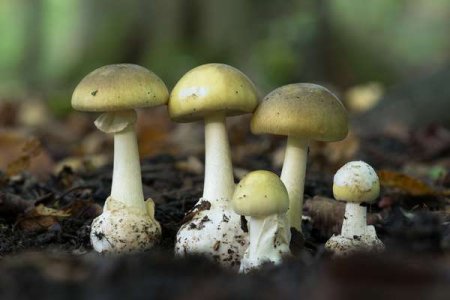Are deadly mushrooms lurking in your next meal? Heed this critical warning!
- Replies 3
As the trend of foraging for wild mushrooms sweeps across social media, Australians are being urged to exercise extreme caution as the practice carries significant risks.
With the trend gaining popularity online, health authorities issue warnings to prevent accidental poisoning, emphasising the importance of proper identification, and avoiding wild mushrooms altogether, if unsure.
The recent surge in mushroom foraging was linked to a tragic incident in Leongatha, Victoria, where three individuals lost their lives after consuming a beef wellington that allegedly contained death cap mushrooms.
This high-profile case from July 2023 had since led to murder and attempted murder charges against Erin Patterson, in connection with the deaths of her estranged husband's parents, Don and Gail Patterson, and aunt Heather Wilkinson, as well as the attempted murder of his uncle Ian Wilkinson.
Ms Patterson is set to defend these charges.

Death cap mushrooms are particularly insidious as they tend to flourish in the weeks following wet weather conditions.
They have been spotted in various regions, including Canberra, Melbourne, Adelaide, and Tasmania.
The Food Safety Information Council has released a statement emphasising the grave dangers associated with wild mushroom foraging, warning Australians to be 'extremely careful' to avoid the potentially fatal consequences of death cap mushroom poisoning.
The surge in recreational mushroom hunting across Australia was fueled by social media influencers who promote foraging for wild food.
The council's Chair, Cathy Moir, expressed her concern on this saying, ‘We are particularly concerned about this growing online promotion of mushroom foraging with some wild mushroom social media groups having over 40,000 members seeking to have their photos of mushrooms identified by fellow foragers.’
Influencers and search engines may not be dependable for accurately identifying Australian mushrooms, as they often only recognize species from the Northern Hemisphere.
Moreover, the appearance of fungi can vary throughout their growth cycle, adding to the difficulty of proper identification.
The stakes are high when it comes to mistaking a death cap mushroom for an edible variety.
Ingesting just a quarter of a cap can be fatal to a healthy adult, and the toxin remains potent even after cooking, peeling, or drying.
Symptoms of poisoning, such as vomiting, diarrhoea, and stomach cramps, typically manifest 10 to 16 hours post-consumption.
While there may be a temporary reprieve in symptoms, the condition can rapidly deteriorate, leading to liver and kidney failure, coma, and death within weeks if not treated promptly and effectively.
The sole survivor of the mushroom tragedy last year also shared the story of how he recovered from the poisoning.
Death cap mushrooms are not the only dangerous species in the wild.
Others, like the Cortinarius and Galerina species, the ghost mushroom (often confused with oyster mushrooms), and the yellow stainer, which resembles a field mushroom, can also cause serious illness.
‘[They] are difficult to distinguish from some other wild mushrooms so we recommend you play it safe and only eat mushrooms that you have purchased from a supermarket, greengrocer or other reputable source,’ Ms Moir said.
‘We recommend supporting local mushroom growers especially as they lost sales last year after extensive media coverage of alleged death cap poisonings.’
She also advised those interested in cultivating mushrooms at home that caution is recommended to prevent accidental contamination with wild spores, which could introduce toxins into the homegrown supply.
This advice was also highlighted after the person who cooked the meal that claimed the lives of three persons last year was described as an ‘experienced forager’.

What are your thoughts on the mushroom foraging trend? Do you know how to identify which mushrooms are edible or not? Let us know your insights in the comments below.
With the trend gaining popularity online, health authorities issue warnings to prevent accidental poisoning, emphasising the importance of proper identification, and avoiding wild mushrooms altogether, if unsure.
The recent surge in mushroom foraging was linked to a tragic incident in Leongatha, Victoria, where three individuals lost their lives after consuming a beef wellington that allegedly contained death cap mushrooms.
This high-profile case from July 2023 had since led to murder and attempted murder charges against Erin Patterson, in connection with the deaths of her estranged husband's parents, Don and Gail Patterson, and aunt Heather Wilkinson, as well as the attempted murder of his uncle Ian Wilkinson.
Ms Patterson is set to defend these charges.

Australians were warned against the growing trend of mushroom foraging to prevent poisoning, particularly with death cap mushrooms. Credits: Shutterstock
Death cap mushrooms are particularly insidious as they tend to flourish in the weeks following wet weather conditions.
They have been spotted in various regions, including Canberra, Melbourne, Adelaide, and Tasmania.
The Food Safety Information Council has released a statement emphasising the grave dangers associated with wild mushroom foraging, warning Australians to be 'extremely careful' to avoid the potentially fatal consequences of death cap mushroom poisoning.
The surge in recreational mushroom hunting across Australia was fueled by social media influencers who promote foraging for wild food.
The council's Chair, Cathy Moir, expressed her concern on this saying, ‘We are particularly concerned about this growing online promotion of mushroom foraging with some wild mushroom social media groups having over 40,000 members seeking to have their photos of mushrooms identified by fellow foragers.’
Influencers and search engines may not be dependable for accurately identifying Australian mushrooms, as they often only recognize species from the Northern Hemisphere.
Moreover, the appearance of fungi can vary throughout their growth cycle, adding to the difficulty of proper identification.
The stakes are high when it comes to mistaking a death cap mushroom for an edible variety.
Ingesting just a quarter of a cap can be fatal to a healthy adult, and the toxin remains potent even after cooking, peeling, or drying.
Symptoms of poisoning, such as vomiting, diarrhoea, and stomach cramps, typically manifest 10 to 16 hours post-consumption.
While there may be a temporary reprieve in symptoms, the condition can rapidly deteriorate, leading to liver and kidney failure, coma, and death within weeks if not treated promptly and effectively.
The sole survivor of the mushroom tragedy last year also shared the story of how he recovered from the poisoning.
Death cap mushrooms are not the only dangerous species in the wild.
Others, like the Cortinarius and Galerina species, the ghost mushroom (often confused with oyster mushrooms), and the yellow stainer, which resembles a field mushroom, can also cause serious illness.
‘[They] are difficult to distinguish from some other wild mushrooms so we recommend you play it safe and only eat mushrooms that you have purchased from a supermarket, greengrocer or other reputable source,’ Ms Moir said.
‘We recommend supporting local mushroom growers especially as they lost sales last year after extensive media coverage of alleged death cap poisonings.’
She also advised those interested in cultivating mushrooms at home that caution is recommended to prevent accidental contamination with wild spores, which could introduce toxins into the homegrown supply.
This advice was also highlighted after the person who cooked the meal that claimed the lives of three persons last year was described as an ‘experienced forager’.
Key Takeaways
- Australians were warned to exercise extreme caution when engaging in the famous trend of mushroom foraging, particularly with the dangerous death cap mushrooms.
- A tragedy linked to death cap mushrooms led to three fatalities, sparking a nationwide warning from the Food Safety Information Council.
- Social media influencers and unreliable identification methods were contributing to the risky foraging practices, despite the life-threatening dangers involved.
- The Food Safety Information Council advised people to only consume mushrooms obtained from reputable sources, and cautions against accidental mix-ups with toxic wild spores for those growing mushrooms at home.
Last edited:







